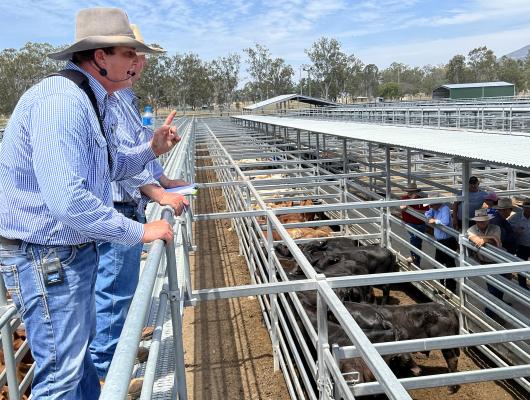
Burnett cattle vendors are celebrating a ’meteoric rise’ in sale prices after an auction at Biggenden on Monday 11 October saw records tumble and big profits made.
Weaner steers from Bundaberg sold for a record-breaking 746.2 cents per kilogram at the 11 October Burnett Livestock & Realty auction at Biggenden, with many other kinds of cattle following closely behind to make for an unprecedentedly profitable event.
Stephanie Whitaker, the Administration Manager at Burnett Livestock & Realty, explained that the surge in prices is the result of a market scrambling for new cattle after a challenging few years.
“There is unprecedented demand for cattle in New South Wales and Queensland; after years of drought, the national herd is quite depleted, and as rain has been not too bad over eastern Australia this year, many producers are restocking and feedlots and processors are still needing to fill space,“ she said.
“This all leads to buyers being prepared to pay more for cattle, and in turn the whole cattle market is stronger.“
Recent fortuitous changes in weather have now seen the region’s farmers come out of hiding, touting their stock at unprecedented prices.
“We have had a bit of rain in our region and the promise of rain to come, so farmers are optimistic about putting cattle in their paddocks and about prices when they need to sell cattle,“ Ms Whitaker said.
“This also affects the flow of cattle onto the market – if prices are low, producers can hang on to their cattle as there is sufficient feed for them – so, for the market to obtain cattle, the prices must be very good to encourage producers to sell.“
A total of five lots sold for over 700 cents on the kilo at Biggenden last week, with several other pens following closely behind the elusive $7 mark.
“The top priced cattle were smaller/younger cattle […] weigh[ing] less than older cattle, hence [a] higher c/kg price than, say, the cattle going to feedlots or processors,“ Ms Whitaker explained.
“The younger, lighter steers always make more c/kg because there is less weight in them. There could also be buyers who specifically want those particular cattle and [are] prepared to go as strong as they need to when bidding. This was partly the case with one or two lots that were over 700c/kg.“
Childers farmer Martin Illet, who saw particular success at Biggenden this month, sold a pen of Droughtmaster cross weaner steers for 744.2 cents per kilo – the second-highest sale of the auction and the highest he has ever sold his stock for.
The Illet farm south of Bundaberg has only just been in business again for 12 months, with Martin and his brother taking over operations from their father.
The runner-up seller of the Biggenden auction said he was content and slightly surprised with his steers’ performance, adding however that prices of this kind are quickly becoming the norm.
“Prices have been on the rise lately,“ Martin said.
“There’s been a shortfall in supply of male cattle in the last 12 months, because there’s been a lot of areas in drought across the state, so there’s a lot of people that are hanging on to their cattle. Coupled with Covid, which shortens supply all over the place, it drives the prices crazy,“ he explained.
The Illets have been breeding cattle since 1989, Martin recalled, with the Biggenden saleyards having long been their main location for selling off their stock.
The steers sold last Monday, he said, were among the first batch of weaners they have raised since taking over operations, with the short-horned cross calves freshly pulled off their mother before the sale.
After their near record-breaking performance earlier this month, the Illets are now looking at a quiet end to the year; having depleted their stock, they will now focus on breeding the next batch of cattle for the March sale season.
“Five years ago, in the middle of the droughts in 2015 and 2016, we were selling cattle for $250 a head – you couldn’t give them away!“ Martin said. Just in September this year, we sold cattle for $1600-1800. It’s been a meteoric rise, really.“





